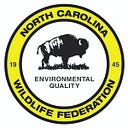Restoration underway for Great Blue Heron rookery in Lake Norman — North Carolina Wildlife Federation
For years, the Lake Norman islands have been favorite gathering spots, landmarks and places to view wildlife. While some are well-protected from wind and waves, other islands are more exposed to natural and man-made elements that cause shorelines to cave, degrade and erode.
Many islands where family and friends used to gather are now shoals marked with a sign on a pole — a stark reminder of the memories made on land that’s now underwater. Through this habitat restoration project, we’re preserving Heron Island from the wind, boat waves and storms that wreak havoc on many of the islands and shorelines around Lake Norman.
NCWF wants the herons to be here for everyone to enjoy for many years to come. That includes all the folks who don’t live on or near the lake but still appreciate watching our Heron Island rookery and osprey nesting cameras during active nesting months. View the cameras at www.ncwf.org and www.lnwc.org.
Restoration project a cooperative effort
A Duke Energy Habitat Enhancement Program (HEP) grant is funding the stabilization project. HEP is a cooperative effort by Duke Energy, North Carolina Wildlife Resources Commission and South Carolina Department of Natural Resources. The program is supported through Duke Energy contributions and fees charged to property owners and developers building piers in Catawba-Wateree Hydro Project reservoirs.
Michael Abney, senior environmental resource manager for Duke Energy, noted the project is a great example of how the HEP can fund the restoration and enhancement of fish and wildlife habitat and one where lake residents can enjoy the benefits of their investment.
You can help support our protection, conservation and restoration efforts by becoming an NCWF member or making a donation.
About the restoration project
The project involves restoring and stabilizing the main channel side of the island that’s eroding by employing a matted rock shoreline with over 300 tons of material and woody vegetation. Native plants, including buttonbush and silky dogwood, will provide brood and forage habitat as well as wildlife food and cover. Additionally, the plants can survive periodic flooding and fluctuating waters and can thrive in most types of moist environments with partial to full sun.
About Great Blue Herons
Great Blue Herons are listed by the NC Natural Heritage Program as a vulnerable species in the Piedmont due to loss and fragmentation of habitats by development along rivers, reservoirs and adjacent floodplain forests. Colonial waterbirds, in general and on Lake Norman, have been identified as a priority conservation resource in the North Carolina Wildlife Action Plan.
In addition, Duke Energy’s Shoreline Management Plan for Lake Norman has implemented protection for these critical heron rookeries found within the Federal Energy Regulatory Commission’s Project Boundary. Duke Energy conducts annual aerial nest surveys for colonial nesting birds (as well as bald eagles) within the Catawba-Water chain of reservoirs, including Lake Norman. The specific rookeries (i.e., islands) are protected under the Colonial Waterbird Nesting Area Program. The boundaries of these habitat areas are posted (with specific signage) and no entry is allowed during the waterbird nesting season from April through August. This species nests in colonies known as “rookeries” or “heronries,” which can contain many nests and thus are classified as colonial nesting waterbirds.
In colonies with many nests and potential nesting sites, males select and defend the highest nest sites. In defending select sites, male birds put on grand displays accompanied by shrieking to attract females. Males present materials and females build a large, bulky nest of sticks, lining the interior with twigs, moss and pine needles. Both adults care for the hatchlings (generally 3–5) within the rookery until they’re ready to fledge.
You can read more about the Heron Island Restoration in the Lake Norman Media Group’s article about the project and the Queen City Nerve’s weekly roundup.
Click here to see video coverage of the story, recorded at Heron Island.
Originally published at https://ncwf.org on March 2, 2020.
